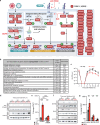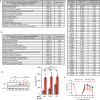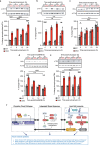Chronic CRYPTOCHROME deficiency enhances cell-intrinsic antiviral defences
- PMID: 39842480
- PMCID: PMC11753882
- DOI: 10.1098/rstb.2023.0344
Chronic CRYPTOCHROME deficiency enhances cell-intrinsic antiviral defences
Abstract
The within-host environment changes over circadian time and influences the replication and severity of viruses. Genetic knockout of the circadian transcription factors CRYPTOCHROME 1 and CRYPTOCHROME 2 (CRY1-/-/CRY2-/-; CKO) leads to altered protein homeostasis and chronic activation of the integrated stress response (ISR). The adaptive ISR signalling pathways help restore cellular homeostasis by downregulating protein synthesis in response to endoplasmic reticulum overloading or viral infections. By quantitative mass spectrometry analysis, we reveal that many viral recognition proteins and type I interferon (IFN) effectors are significantly upregulated in lung fibroblast cells from CKO mice compared with wild-type (WT) mice. This basal 'antiviral state' restricts the growth of influenza A virus and is governed by the interaction between proteotoxic stress response pathways and constitutive type I IFN signalling. CKO proteome composition and type I IFN signature were partially phenocopied upon sustained depletion of CRYPTOCHROME (CRY) proteins using a small-molecule CRY degrader, with modest differential gene expression consistent with differences seen between CKO and WT cells. Our results highlight the crosstalk between circadian rhythms, cell-intrinsic antiviral defences and protein homeostasis, providing a tractable molecular model to investigate the interface of these key contributors to human health and disease.This article is part of the Theo Murphy meeting issue 'Circadian rhythms in infection and immunity'.
Keywords: CRYPTOCHROME; circadian rhythms; integrated stress response; interferon; protein homeostasis; virus.
Conflict of interest statement
We declare we have no competing interests.
Figures



References
MeSH terms
Substances
Grants and funding
LinkOut - more resources
Full Text Sources
